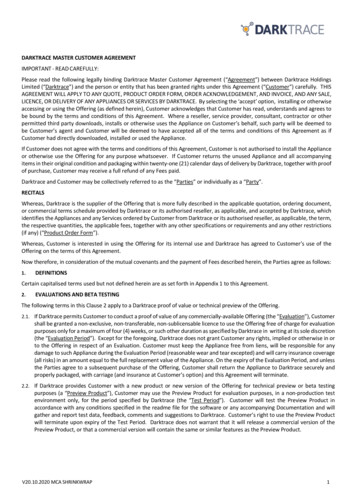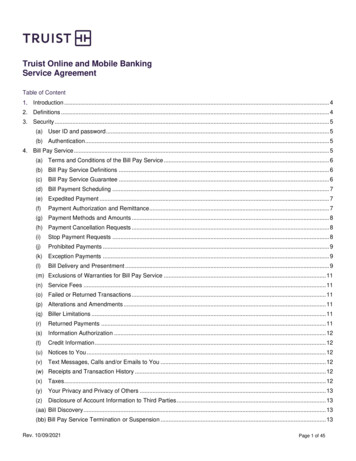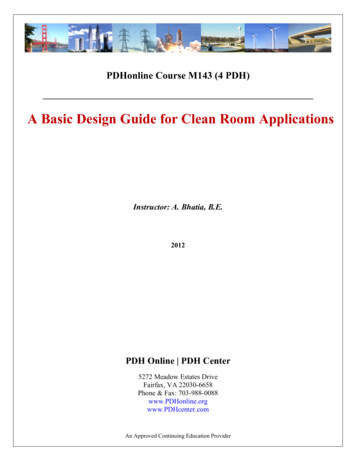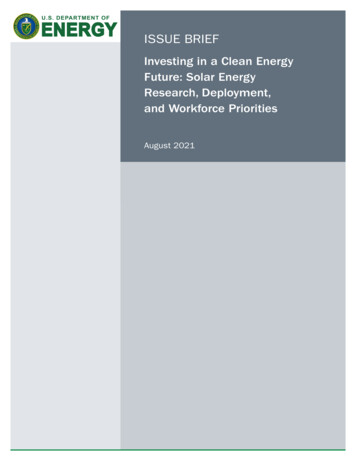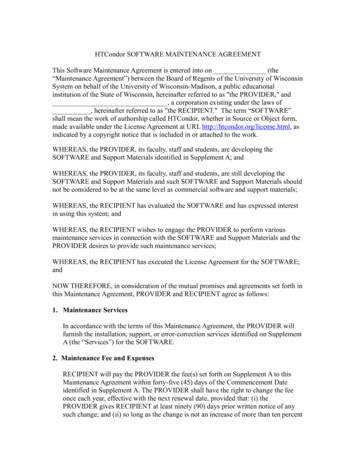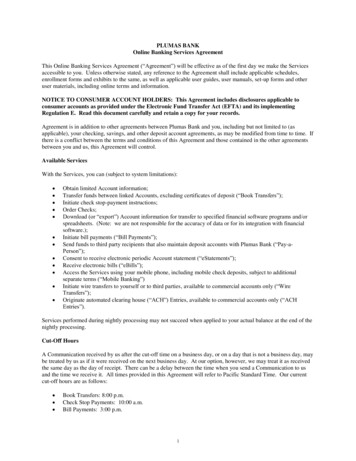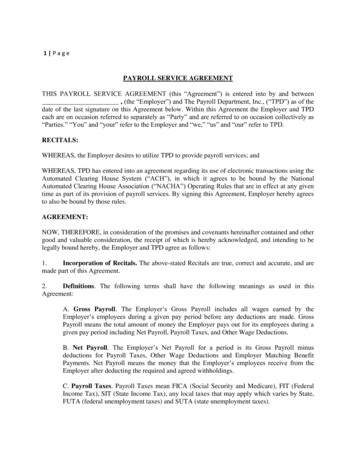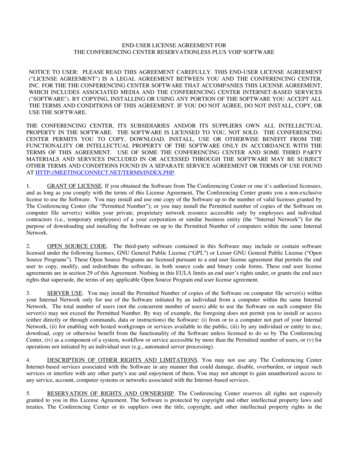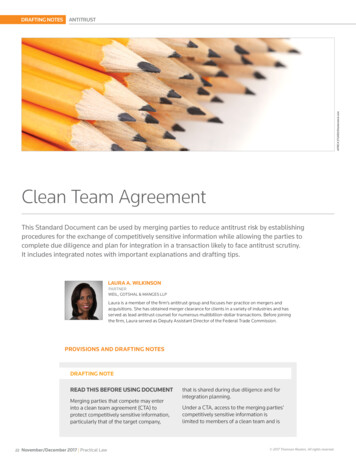
Transcription
ANTITRUSTAFRICA STUDIO/Shutterstock.comDRAFTING NOTESClean Team AgreementThis Standard Document can be used by merging parties to reduce antitrust risk by establishingprocedures for the exchange of competitively sensitive information while allowing the parties tocomplete due diligence and plan for integration in a transaction likely to face antitrust scrutiny.It includes integrated notes with important explanations and drafting tips.LAURA A. WILKINSONPARTNERWEIL, GOTSHAL & MANGES LLPLaura is a member of the firm’s antitrust group and focuses her practice on mergers andacquisitions. She has obtained merger clearance for clients in a variety of industries and hasserved as lead antitrust counsel for numerous multibillion-dollar transactions. Before joiningthe firm, Laura served as Deputy Assistant Director of the Federal Trade Commission.PROVISIONS AND DRAFTING NOTESDRAFTING NOTEREAD THIS BEFORE USING DOCUMENTMerging parties that compete may enterinto a clean team agreement (CTA) toprotect competitively sensitive information,particularly that of the target company,22November/December 2017 Practical Lawthat is shared during due diligence and forintegration planning.Under a CTA, access to the merging parties’competitively sensitive information islimited to members of a clean team and is 2017 Thomson Reuters. All rights reserved.
protected from disclosure. The clean teammay comprise a small group of people or alarge team of people, and the competitivelysensitive information may be located in aseparate electronic or physical data room,sometimes called a clean room.Although the target’s information is typicallyprotected by a confidentiality agreement,merging parties may take the additionalstep of entering into a CTA for the mostsensitive information where: The transaction is likely to receiveantitrust scrutiny from the Federal TradeCommission (FTC) or the Antitrust Divisionof the Department of Justice (DOJ). The merging parties have significantcompetitive overlaps. A large volume of competitively sensitiveinformation will be shared.In practice, most transactions do not needa CTA because they do not involve thesefactors.The disclosure of competitively sensitiveinformation during due diligence,negotiations, and integration planningbetween competitors can give rise toantitrust concerns, even if the transactiondoes not close. These exchanges can violatethe antitrust laws because they can facilitateor invite collusion. Access to the seller’scompetitively sensitive information may alsohurt the target and competition as a wholeif the buyer gains a competitive advantageover the target and the deal does not close.Exchanges of information may violate: Section 1 of the Sherman Act, whichprohibits agreements that unreasonablyrestrain trade, such as competitorsagreeing or colluding on price (formore information, search Establishingan Agreement Under Section 1 of theSherman Act). Section 5 of the FTC Act, which broadlyprohibits unfair methods of competitionand unfair or deceptive acts or practices(for more information, search FTC ActSection 5: Overview). Search Information Exchange and IntegrationPlanning in M&A: Antitrust for more on theantitrust issues relevant to the exchange ofinformation between merging parties. 2017 Thomson Reuters. All rights reserved.ADVANTAGES AND DISADVANTAGESOF USING A CTAMerging parties should weigh theadvantages of exchanging competitivelysensitive information by using a CTA, suchas enabling detailed synergy analysis andintegration planning, against the potentialfor anticompetitive effects, as well as the riskthat an antitrust agency may have concernsabout the information exchanges, which mayextend the antitrust agency’s investigation.By entering into a CTA, members of theclean team can review competitivelysensitive information on pricing, costs,customers, and employees that the mergingparties could not independently view. Accessto this information allows the mergingparties to: Use the due diligence period and timebetween signing and closing moreproductively so that they can beginintegration earlier and rely on data ratherthan assumptions. Evaluate clearance strategies based onan analysis of both companies’ assetperformance and valuation, includingdeciding which assets to divest to remedyan antitrust concern.Additionally, the buyer can get a headstart, often of several months, on analyzingthe financial impact of the transaction,including deal synergies and efficiencies andpreparing integration plans.However, clean teams should be usedsparingly because their implementation: Can be expensive. Places a significant burden on themerging parties, including by preventingmembers of the clean team fromreturning to certain roles if the transactiondoes not close. Takes a significant amount of time toadminister.TIMING OF ENTERING INTO A CTAMerging parties that decide to enterinto a CTA should do so after executinga confidentiality agreement, but beforereceiving any required approval under theHart-Scott-Rodino (HSR) Act.The Journal Transactions & Business November/December 2017 23
DRAFTING NOTESANTITRUSTThe antitrust agencies have authorityto review all transactions, not just thoserequiring HSR approval. In non-HSRreportable transactions, merging partiesshould enter into a CTA where therepotentially are significant antitrust issuesthat make antitrust review likely.COVERED INFORMATIONClean teams handle competitively sensitiveinformation, such as information about: Sales strategies. Pricing, including pricing plans. Sales or promotional plans. Strategic plans. Customers and suppliers (including detailsof contracts with customers and suppliers,such as prices, volumes, and terms). Product performance. Future product plans, including researchand development projects.profitability, are generally reviewed byantitrust counsel to ensure they do notreveal competitively sensitive information(meaning, they are clean) before beingdistributed more broadly.The CTA should specify that the clean teammembers can only use the information forthe stated purpose (generally due diligenceor integration planning) and that they cannotshare the information further within theircompany. The CTA generally provides that allconfidential information is either returned ordestroyed if the transaction does not close.ASSEMBLING THE CLEAN TEAMThe clean team is generally composedof members that are familiar with datamanagement and the relevant industry.Members may include: Internal employees of the merging partiesthat are:zz Plant and equipment or facilityperformance.The clean team may prepare reports for themerging parties’ boards or managementthat aggregate or summarize the informationin a format that masks the sensitive details.removed from day-to-day responsibilitieswhile serving on the clean team andfor a sufficient period of time for theexchanged information to becomestale should the transaction not close(usually six months to two years).Some CTAs define competitively sensitiveinformation, while others state that it includesinformation either merging party deems to becompetitively sensitive or confidential, suchas proprietary, strategic, financial, pricing,production, and operational information. Outside consultants, such as a lawThe CTA may require that clean teammaterial be marked by the disclosing partyas “clean team material.” The mergingparties (or their antitrust counsel) generallywill agree about how material is classified.However, it is possible that, for example,the target may attempt to keep certaininformation out of the hands of the buyer’skey decision makers by liberally classifyingmaterial as clean team material.A buyer is generally restricted fromplacing key current employees responsiblefor the products or services at issue onthe clean team. Therefore, the buyer mayinstead choose:Members of the clean team generally areprohibited from disseminating clean teammaterials to anyone other than clean teammembers. Reports prepared by clean teammembers that aggregate or summarizecompetitively sensitive information, suchas those on customer contract pricing or24zznot involved in the competingproducts’ day-to-day operations (forexample, pricing, marketing, sales, orproduction); orNovember/December 2017 Practical Lawfirm, an accounting firm, or an economicconsulting firm.(See Beau W. Buffier, Jessica K. Delbaum,and Matthew Jennejohn, Mergers, AntitrustAdvisor, § 4.90 (West 5th ed. 2016).) Employees working in a financial capacity. Recently retired employees.Alternatively, the buyer may use internalemployees but agree to assign them tonew jobs if the transaction does not closeto prevent them from using competitivelysensitive information gained throughthe clean team to the competitor’sdisadvantage. 2017 Thomson Reuters. All rights reserved.
In some transactions, it may be preferableto use outside consultants rather thaneither merging party’s internal employeesto eliminate the actual or perceived risk ofan anticompetitive information exchange.Outside consultants may be usefulbecause they: Can freely gather and examine sensitiveor competitive data on costs, customers,or employees from both merging partiesthat otherwise cannot be shared. Have experience analyzing the applicableinformation, evaluating businessoperations, and developing detailedintegration plans.ROLE OF ANTITRUST COUNSELThe clean team often works at the requestof, or in connection with, legal counsel.Each merging party should engage its ownantitrust counsel. Antitrust counsel should: Consider the client’s goals in using theclean team, including:zzzzwhat reports should be prepared; andhow the reports should be prepared,including data aggregation andanalytical methodologies andassumptions. Determine and negotiate:zzzzzzzzthe clean team members, whetheroutside consultants, internalemployees, or both;the party paying the costs of outsideconsultants working on the clean team;the definition of competitively sensitiveinformation;the expected level of disclosure byeach merging party, such as whetherthey intend to provide projectionsfor the future or only historic data orinformation;zzzzzzzzhow clean team materials are to betreated if the transaction does not close;how clean team members are to betreated if the transaction does not close;the clean team’s governance structure,typically a committee of executivesfrom each merging party; andhow disputes should be resolved by thegovernance committee. Ensure that each merging party hasexecuted a confidentiality agreementsetting out the levels of disclosure andhow data and information are handled. Discuss whether specific information hasbeen correctly designated as clean teammaterial. Maintain a record of shared information andreview the clean team reports to ensurethat they meet appropriate criteria fordistribution to non-clean team members.ANCILLARY AGREEMENTSIn addition to signing a confidentialityagreement, merging parties executing aCTA should also execute a joint defenseagreement (JDA). A JDA allows counselto merging parties to share confidentialinformation under the common interest andjoint defense privilege without waiving theattorney-client privilege, the work productprivilege, or other privileges. Search Joint Defense Agreement for MergerInvestigations for a model JDA, withexplanatory notes and drafting tips.The merger agreement sometimes statesthat a CTA is in place and specifies that anyinformation that the target believes in goodfaith is competitively sensitive information isto be shared under the terms of the CTA. CLEAN TEAM AGREEMENTThis Clean Team Agreement (the “Agreement”) is entered into by and between [BUYERNAME] and its affiliates, and [SELLER NAME] (collectively the “Parties”) on [DATE].WHEREAS, the Parties are considering a potential transaction involving the combinationof their businesses;WHEREAS, the Parties wish to ensure the proper treatment of certain competitivelysensitive [SELLER NAME] information that may be exchanged for purposes of [BUYER NAME]’sevaluation of this potential transaction; 2017 Thomson Reuters. All rights reserved.The Journal Transactions & Business November/December 2017 25
DRAFTING NOTESANTITRUSTWHEREAS, the Parties wish to ensure the proper treatment of certain competitively sensitiveinformation that may be exchanged for the purpose[s] of [[analyzing synergies and integrationplanning] [and/or] [conducting due diligence]] with respect to this potential transaction;DRAFTING NOTEINFORMATION EXCHANGED FORDUE DILIGENCE AND INTEGRATIONPLANNINGA CTA helps protect the parties’ exchangeof competitively sensitive informationshared for specific legitimate purposes,such as to:zzzzsynergies, meaning how the companiesare likely to perform better togetherthan apart; andefficiencies or cost savings. Plan for integration, to ensure a smoothtransition and to achieve synergies quicklyon closing. Complete due diligence. Evaluate and value the proposed transaction,including whether it is likely to lead to:WHEREAS, the Parties have agreed to limit the access to and use of such competitivelysensitive information by [BUYER NAME] employees, affiliates, and agents for this reason; andWHEREAS, the terms of the confidentiality agreement between [BUYER NAME] and[SELLER NAME], dated as of [DATE] (the “Confidentiality Agreement”), will remain in full forceand effect, and this Agreement supplements the Confidentiality Agreement;NOW, THEREFORE, the Parties hereto agree as follows:1.The following documents and data, as they relate to [BUSINESS UNIT], will be deemed tobe and defined as “Competitively Sensitive Information” for purposes of this Agreement:a. Detailed information regarding pricing, including pricing strategy;b. Details of sales strategies or pricing plans, sales or promotional plans, strategic plans,future product plans, and other information concerning future strategies; andc. Other documents and data determined by [SELLER NAME] to be competitivelysensitive, provided that the nature of such documents shall be identified to the Clean Team (asdefined herein) promptly after such documents or data are provided to the other party.2.[BUYER NAME] represents and warrants to [SELLER NAME] that the CompetitivelySensitive Information identified in Section 1 is necessary for its evaluation of this potentialtransaction between [BUYER NAME] and [SELLER NAME].3.Competitively Sensitive Information shall be disclosed by [SELLER NAME] only toindividuals who (x) are employed by one of the entities named in (a) or (b) below, (y) sign anacknowledgement in the form of Exhibit A attached hereto, and (z) are either named in Exhibit Battached hereto or approved in writing by [SELLER NAME] upon request by [BUYER NAME](collectively, the “Clean Team”); provided, however, that nothing contained in this Agreement inany way shall obligate, or be interpreted to obligate, [SELLER NAME] to provide any documents ordata to the Clean Team or [BUYER NAME].a. [NAME OF OUTSIDE LAW FIRM].b. [NAME OF INVESTMENT BANKERS/NAME OF CONSULTANTS].[SELLER NAME] shall also have the sole right to determine the scope of documents to discloseto the Clean Team in response to requests by [BUYER NAME] to review Competitively SensitiveInformation for the purpose of evaluating this potential transaction.26November/December 2017 Practical Law 2017 Thomson Reuters. All rights reserved.
[BUYER NAME] represents and warrants to [SELLER NAME] that none of the individuals who willparticipate on the Clean Team currently have, or are reasonably likely to have [in the foreseeablefuture/for a period of [twelve (12) months/OTHER TIME PERIOD] following the date this potentialtransaction is terminated], direct pricing, sales, or marketing responsibilities for [BUYER NAME] orany competitor of [SELLER NAME].4.[BUYER NAME] agrees and agrees to cause each member of the Clean Team: (a)to maintain the confidentiality of Competitively Sensitive Information; (b) not to discloseCompetitively Sensitive Information to any persons other than the Clean Team; (c) to return ordestroy all Competitively Sensitive Information promptly upon request of [SELLER NAME] (withsuch destruction to be certified in writing by the authorized officer of [BUYER NAME] supervisingsuch destruction), in accordance with Section [SECTION NUMBER] of the ConfidentialityAgreement; and (d) not to use Competitively Sensitive Information for purposes other thanevaluating this potential transaction, in accordance with Section [SECTION NUMBER] of theConfidentiality Agreement.5.[BUYER NAME] shall cause [the Clean Team/BUYER’S LAW FIRM] to provide [SELLERNAME]’s outside counsel, [SELLER’S LAW FIRM], on an outside-counsel-only basis, with anadvance copy of each written report generated by the Clean Team with respect to the CleanTeam’s review of Competitively Sensitive Information, provided that the Clean Team may redactfrom such advance copy any conclusions reached by the Clean Team so long as such redactedinformation does not include any Competitively Sensitive Information. [SELLER’S LAW FIRM]must approve the advance copy of each written report or provide a list of specific objections inwriting by [REASONABLE DEADLINE] if the advance copy is sent to it between [TIME FRAME][Eastern Standard Time/TIMEZONE] of [the same day/the previous day], based on electronicmail time stamps. [SELLER’S LAW FIRM] must approve the advance copy of each written reportor provide a list of specific objections in writing by [TIME FRAME] if the advance copy is sent toit [between 12:01 p.m. and 11:59 p.m. of the preceding calendar day/TIME FRAME], based onelectronic mail time stamps. Such written report may be furnished to [BUYER NAME] if, and onlyif, such written report is approved in writing in advance by [SELLER’S LAW FIRM] and no changesare made in such written report after it is approved other than the restoration of conclusionsredacted in accordance with this Agreement. If [SELLER’S LAW FIRM] does not approve theadvance copy of such written report or provide a list of specific objections in the relevant time perioddenoted, the written report shall be deemed approved and may be furnished to [BUYER NAME].DRAFTING NOTECLEAN TEAM REPORTSCounsel should customize the bracketedlanguage to specify a reasonable deadline forthe seller’s law firm to approve the advancecopy of any written report that is receivedwithin a specified time frame. For example,counsel may specify that an advance copyreceived the previous day before 11:59 p.m.is to be approved by 6:00 p.m. EasternStandard Time the following day.6.[BUYER NAME] agrees to be responsible and liable for any breach of this Agreement byany member of the Clean Team.[Signatures][Exhibit A: ACKNOWLEDGMENT][Exhibit B: Approved Members of the Clean Team] Search Clean Team Agreement for the complete, onlineversion of this resource, which includes relevant exhibitsto the CTA. 2017 Thomson Reuters. All rights reserved. Use of Practical Law websites andservices is subject to the Terms of Use (http://us.practicallaw.tr.com/2-383-6690)and Privacy Policy (http://us.practicallaw.tr.com/8-383-6692).The Journal Transactions & Business November/December 2017 27
The clean team often works at the request of, or in connection with, legal counsel. Each merging party should engage its own antitrust counsel. Antitrust counsel should: Consider the client’s goals in using the clean team, including: z what reports should be prepared; and z how the reports should be


